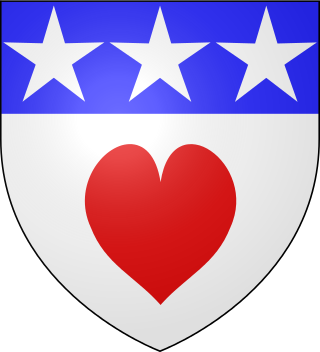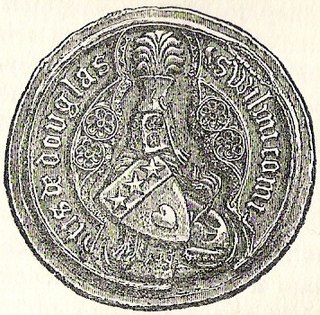This article needs additional citations for verification .(November 2024) |
Margaret of Mar (died c. 1391) was Countess of Mar, an ancient earldom in Scotland, in her own right. [1]
This article needs additional citations for verification .(November 2024) |
Margaret of Mar (died c. 1391) was Countess of Mar, an ancient earldom in Scotland, in her own right. [1]
She was a daughter of Domhnall II of Mar and became Countess of Mar in her own right after the death of her brother Thomas, 9th Earl of Mar. She had married William Douglas, 1st Earl of Douglas, who was styled Earl of Mar by right of his wife, [2] and who was succeeded by their son, James Douglas, 2nd Earl of Douglas and Earl of Mar and Garioch in right of his mother. He was killed in 1388, leading the Scots at the Battle of Otterburn. [3]
Margaret was succeeded by her daughter, Isabel, who became Countess of Mar, [1] possessed the Lordship of the Garioch, and also became the Countess of the unentailed lands of the House of Douglas. [4]

Robert II was King of Scots from 1371 to his death in 1390. The son of Walter Stewart, 6th High Steward of Scotland, and Marjorie, daughter of King Robert the Bruce, he was the first monarch of the House of Stewart. Upon the death of his uncle David II, Robert succeeded to the throne.
There are currently two earldoms of Mar in the Peerage of Scotland, and the title has been created seven times. The first creation of the earldom is currently held by Margaret of Mar, 31st Countess of Mar, who is also clan chief of Clan Mar. The seventh creation is currently held by James Erskine, 14th Earl of Mar and 16th Earl of Kellie, who is also clan chief of Clan Erskine.

Earl of Lincoln is a title that has been created eight times in the Peerage of England, most recently in 1572. The title was borne by the Dukes of Newcastle-under-Lyne from 1768 to 1988, until the dukedom became extinct.

Earl of Rothes is a title in the Peerage of Scotland. It was created in 1458 for George Leslie, 1st Lord Leslie. He had already been created Lord Leslie in 1445, also in the Peerage of Scotland. His grandson, the third Earl, having only succeeded his elder brother in March 1513, was killed at the Battle of Flodden on 9 September of the same year. His son, the fourth Earl, served as an Extraordinary Lord of Session. Lord Rothes was also tried for the murder of Cardinal Beaton but was acquitted.

The Mormaer or Earl of Buchan was originally the provincial ruler of the medieval province of Buchan. Buchan was the first Mormaerdom in the High Medieval Kingdom of the Scots to pass into the hands of a non-Scottish family in the male line. The earldom had three lines in its history, not counting passings from female heirs to sons. Today, it is held by the Erskine family as a peerage. The current holder is Harry Erskine, 18th Earl of Buchan. Subsidiary titles are Lord Cardross and Lord Auchterhouse and Baron Erskine.

Earl of Carrick is the title applied to the ruler of Carrick, subsequently part of the Peerage of Scotland. The position came to be strongly associated with the Scottish crown when Robert the Bruce, who had inherited it from his maternal kin, became King of Scots in the early 14th century. Since the 15th century, the title of Earl of Carrick has automatically been held by the heir apparent to the throne, thus the current holder of the title is Prince William, Duke of Rothesay.

Robert Stewart, Duke of Albany was a member of the Scottish royal family who served as regent to three Scottish monarchs. A ruthless politician, Albany was widely regarded as having murdered his nephew, the Duke of Rothesay, and brother to the future King James I of Scotland. James was held in captivity in England for eighteen years, during which time Albany served as regent in Scotland, king in all but name. He died in 1420 and was succeeded by his son, Murdoch Stewart, Duke of Albany, who was executed for treason when James returned to Scotland in 1425, almost causing the complete ruin of the Albany Stewarts.

The Mormaer or Earl of Angus was the ruler of the medieval Scottish province of Angus. The title, in the Peerage of Scotland, is held by the Duke of Hamilton, and is used as a courtesy title for the eldest son of the Duke's eldest son.
Sir James Douglas, 2nd Earl of Douglas and Mar was an influential and powerful magnate in the Kingdom of Scotland.

This page is concerned with the holders of the forfeit title Earl of Douglas and the preceding feudal barons of Douglas, South Lanarkshire. The title was created in the Peerage of Scotland in 1358 for William Douglas, 1st Earl of Douglas, son of Sir Archibald Douglas, Guardian of Scotland. The Earldom was forfeited by James Douglas, 9th Earl of Douglas, in 1455.

Margaret Alison of Mar, 31st Countess of Mar, is a Scottish hereditary peer and politician. She was a crossbench member of the House of Lords from 1975 to 2020 and was one of 92 hereditary peers elected to remain in the Lords in 1999. She is the holder of the original earldom of Mar, the oldest peerage title in the United Kingdom. She is the only suo jure countess and was the only female hereditary peer in the House of Lords from 2014 to 2020. She is also a farmer and former specialist goats cheesemaker in Great Witley, Worcestershire.
Thomas, Earl of Mar, was a 14th-century Earl of Mar, an earldom located in the County of Aberdeen, Scotland. He is sometimes styled Mormaer of Mar since mormaer was the Scottish Gaelic equivalent of the English word earl. Because the identification and numbering of the ancient earls of Mar is debatable, Thomas is variously numbered the ninth, tenth, or thirteenth. of the ancient earls. He was a son of Domhnall II of Mar, who fell at the Battle of Dupplin Moor in 1332.

Archibald Douglas, Earl of Douglas and Wigtown, Lord of Galloway, Douglas and Bothwell, called Archibald the Grim or Black Archibald, was a late medieval Scottish nobleman. Archibald was the illegitimate son of Sir James "the Black" Douglas, Robert the Bruce's trusted lieutenant, and an unknown mother. A first cousin of William Douglas, 1st Earl of Douglas, he inherited the earldom of Douglas and its entailed estates as the third earl following the death without legitimate issue of James, 2nd Earl of Douglas at the Battle of Otterburn.

William Douglas, 1st Earl of Douglas was a Scottish nobleman, peer, magnate, and head of the Black Douglas family. Under his leadership, the Black Douglases continued their climb to pre-eminence in Scottish politics begun under his uncle, Sir James the Good, as well as their military dominance of the south of Scotland.

Alexander Stewart was a Scottish nobleman, originally the Earl of Moray, he became the Earl of Mar from 1405. He acquired the earldom through marriage to the hereditary countess, and successfully ruled the northern part of Scotland.

Clan Mar is a Scottish clan of the Scottish Lowlands. It is also officially known as the Tribe of Mar. The chiefs of the Clan Mar were the original Earls of Mar, although this title later went via an heiress to the Douglases in the late fourteenth century, and then to the Stewarts before going to the Erskines. The current chief of Clan Mar is Margaret of Mar, Countess.
George Douglas, 1st Earl of Angus (1380–1403) was a Scottish nobleman and peer.

Isabel Douglas, Countess of Mar was Countess of Mar.

Agnes Leslie, Countess of Morton was a Scottish noblewoman, being the daughter of George Leslie, 4th Earl of Rothes. She was the wife of William Douglas, 6th Earl of Morton, who as Laird of Lochleven Castle was the custodian of Mary, Queen of Scots during her captivity from June 1567 until her escape on 2 May 1568. Agnes was Queen Mary's chief female companion throughout her imprisonment; thus it was while Lady Agnes was recovering from childbirth that the queen successfully escaped from Lochleven.

William Graham, 5th Earl of Menteith, was a 16th-century Scottish nobleman.